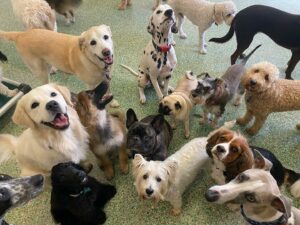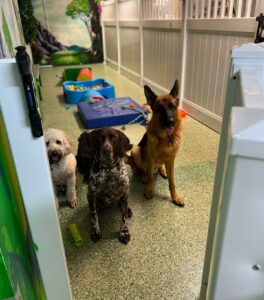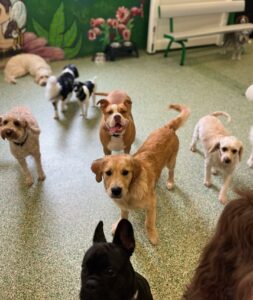Doggy Daycare can be an excellent way to socialise and stimulate your pup however, there are certain behaviours that can prohibit them from thriving at daycare or result in them being deemed unfit – which of course none of us wants! To better the chances of your pup thriving, here are some ways you can reinforce the behaviours we require to keep your pup safe, happy and healthy at daycare!
*Disclaimer*
Sometimes you may be told about behaviours your pup has displayed at daycare that seem out-of-character – this is completely normal! Daycare can be a new and stimulating environment that can cause pups to act differently from how they would at home or when out with their owners where they are familiar.
Reinforcing obedience cues
Our team is trained and well-practised in reading dog behaviour, meaning that we are able to see if play is getting too rough and intervene when necessary to always ensure the dog’s safety and enjoyment.
In an exciting and stimulating environment such as doggy daycare, it is important for us to be able to call your pup’s name/recall word and have them come to us. This allows us to control the big groups we have at daycare without having to use physical force and ensures the safety of the dogs.
You can reinforce these obedience cues both at home and in public in a variety of calm and busy scenarios to fine-tune your pup’s recall response. One of the simplest ways to practise this would be to call their name/recall word and reward with a treat when they come to you. Practising this in busy situations where your pup may be distracted is a great way to ensure they are familiar with responding even when preoccupied – the hope is that this will translate into coming when called, even if in the middle of play! Obedience cues are also one of the best ways for your pup to bond with our team; responding to obedience calls with the team builds a level of trust and respect, especially when your pup gets those extra rewards and cuddles for coming to us when called!
 Gate/door manners
Gate/door manners
An issue we sometimes face with pups is being too eager to get through the gates and/or doors. This is usually a result of wanting to explore what’s on the other side or noticing when pups are starting to go home at the end of the day and trying their luck of being the next to go!
Although we understand that the pup is just trying to get to where they want to go, it can pose a safety concern for a couple of reasons:
- The pup may be pushing their way into an area of dogs of different sizes/temperaments/energy levels to them. For example, if a small, nervous dog pushes their way into a section with larger, more energetic pups, they may become involved in an involuntary game of chase simply because they are small, new, and exciting to the other pups. In the same way, if a larger pup gets into an area with smaller, older pups they are at risk of potentially knocking over these frailer dogs.
- There can be a lot of energy around gates when being opened (especially at the beginning and end of the day) so if a pup is pushing through the other dogs in an attempt to get through, others may get a bit nippy which can escalate into a scuffle.
For these reasons, it is best to be able to keep pups in their assigned sections so that each is with others of similar temperament, play style and size so that they have a safe, social and fun day!
If gate manners have been communicated as a behaviour to work on with your pup, try working on door manners at home. This could involve having something of high value (eg. a treat/toy/a person your pup loves) on the other side of a door, but only allowing them to go through the door once you have opened it and given them the ok. This will hopefully translate into them knowing to wait to be asked through gates and doors at daycare.
Helping pups who bark excessively
Another behaviour that is unfavourable at daycare is excessive barking. Of course, most dogs bark from time to time while at daycare, however, it is when it gets to a point where they are barking continuously with little to no breaks that it can become an issue.
Continuous barking can encourage others to do the same and potentially overstimulate pups (imagine the noise level if all the dogs that came into daycare were barking all at once!). This can also be taxing on our team to be around excessive barkers for hours at a time while out the back with them.
Often this type of barking is a result of being a little bit unsure of their new environment, and/or the absence of a familiar person – but don’t worry, your pup will get to know and love us soon enough.
Here are some things to try at home to remedy a pup who barks excessively:
- When your pup is barking, try a calm yet firm voice saying a command such as “quiet”, and rewarding once the barking ceases.
- A tired dog is a quiet dog. If you have the time, try taking your pup for a walk in the morning before dropping them off at daycare, spend 10-15 minutes playing fetch, or give them a lickimat to stimulate their brain (even brain stimulation can tire out a dog!)
- If you know your pup is one to bark when you leave the house, when you have time (perhaps on a weekend) try leaving the house but remaining within earshot. If they bark, go back into the house and use the command word such as “quiet”. Once they stop barking, reward and repeat. This can slowly become waiting for them to stop themselves barking before returning to the house. Note: This tip ONLY works IF the “quiet” command has been trained well first. Otherwise, you actually want to do the opposite and leave the house, wait and only return after they have been quiet for a little while. This way they learn to be calm, and that being quiet gets them the desired outcome.
Another great way to improve obedience and the ability to learn new commands or expected behaviours is by hiring a trainer or attending an obedience course. If you have implemented any verbal or visual commands or gestures at home, please be sure to let us know so that we can use them with your pup at daycare. This will not only benefit us being able to use commands they respond to, but will also help them practise them in a new environment.